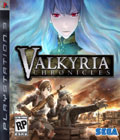Genre: Action/Role-Playing
Publisher: Sega
Developer: Sega
Release Date: November 4, 2008
Sega's upcoming Valkyria Chronicles has been getting a lot of notice for its highly original visual style. Using the proprietary CANVAS engine, Valkyria Chronicles manages to simulate the look of a watercolor painting in motion. It's a distinct look that is as much art as it is functional. Remove the HUD, freeze the action and you could easily make a poster from any sequence in the game.
Pretty graphics alone aren't enough to make a game, but from what we've seen so far, Valkyria Chronicles doesn't skimp on the gameplay, which appears to be just as polished as the visuals.
Set in an alternate world, Valkyria Chronicles takes place in the mid-1930s in greater Europa. The Imperial Alliance and Atlantic Federation are at war, and the small nation of Gallia is caught in the middle. Ostensibly neutral, Gallia is rich in natural resources and surrounded by the warring factions. It was only a matter of time before they were attacked, and that time has come.
Leading your troops into battle to defend Gallia is no simple task, as the characters in Valkyria Chronicles aren't simple paper cutouts. Sure, you've got the main characters like Welkin Gunther and Alicia Melchiott who drive the story, but all of the secondary characters also have individual names and personalities. This comes into play a number of ways, both in experience and in battlefield quirks.
Experienced fighters perform better in combat, so there is an incentive to keep your troops alive. Experience also allows for upgraded weapons and vehicles. If one falls in battle you can revive them with a medic, but wait too long, and it's sayonara. Once characters die, you've lost them for good.
Aside from the standard class skills, each character also has individual personality traits that may manifest depending on the circumstances. For example, one fighter may like open fields, so he'll fight better in the country than he will in confined city levels. Learning your fighters is key to success.
As your army grows, you'll not only be tasked with defeating the enemy, but also choosing the correct troops for the battle. Assemble an appropriate team, and winning will be an easier task than if you take the wrong force. According to a Sega rep who demoed the game for us, every map in the game can be won in a single round if you know exactly what you're doing. The one-round win tactics aren't immediately obvious, but for the hardcore, that's certainly a challenge to aspire toward.
Actual combat is a mix of pseudo-real-time and turn-based action. After choosing your troops and entering the battlefield, you select a soldier, and the game transitions to real time. Here you can move in any direction you wish, but you are limited by your movement points. Enemies will react, though if you switch into fine aim mode, the action pauses, allowing you to line up a shot. Each shot is given a success percentage along with damage, so you can assess the best method of taking out an opponent. If you don't kill an enemy with a shot, they will retaliate.
After the character's movement points are used up, the game returns to the map screen, allowing you to choose again so long as you have turns remaining in the round. It is possible to keep using the same character, but doing so tires out the fighter, and each consecutive turn results in fewer movement points for that fighter.
The environment plays a role in combat, with a combination of natural cover and destructible obstacles. For example, plants and trees can make it harder for an enemy to target you, while small walls can either be navigated around or destroyed. If used wisely, snipers on high ground can eliminate the cover advantage.
Character design is well done, with an incredible number of individual portraits. Among those on the battlefield, eagle-eyed fans are sure to notice Aika, Fina and Vyse (from Skies of Arcadia) making an appearance.
To our great disappointment, Valkyria Chronicles is very much a single-player game. There is no multiplayer mode, so testing your combat skills against a friend is out of the question. No, multiplayer isn't a requirement for a good game, but it's certainly nice to have, especially in a game that centers on strategic conflict.
We'll have a final verdict on the game next month, but until there be sure to enter WorthPlaying's Valkyria Chronicles contest. Two lucky winners will each receive a copy of Valkyria Chronicles autographed by the producer of the game, Ryutaro Nonaka.
More articles about Valkyria Chronicles











 Valkyria Chronicles is set in a fictitious continent reminiscent of 1930s Europe - divided in two and ruled by the Empire and the Federation. The game follows a hero named Welkin and his fellow soldiers of the Federations 7th Platoon as they engage in a series of epic battles.
Valkyria Chronicles is set in a fictitious continent reminiscent of 1930s Europe - divided in two and ruled by the Empire and the Federation. The game follows a hero named Welkin and his fellow soldiers of the Federations 7th Platoon as they engage in a series of epic battles.




























